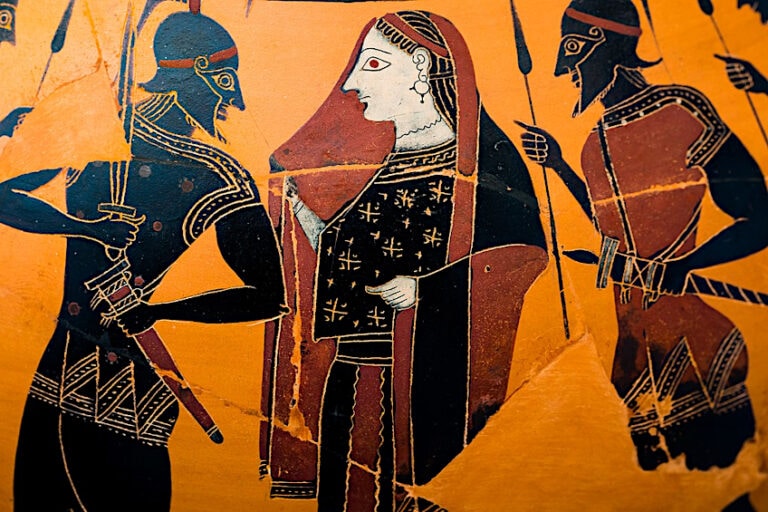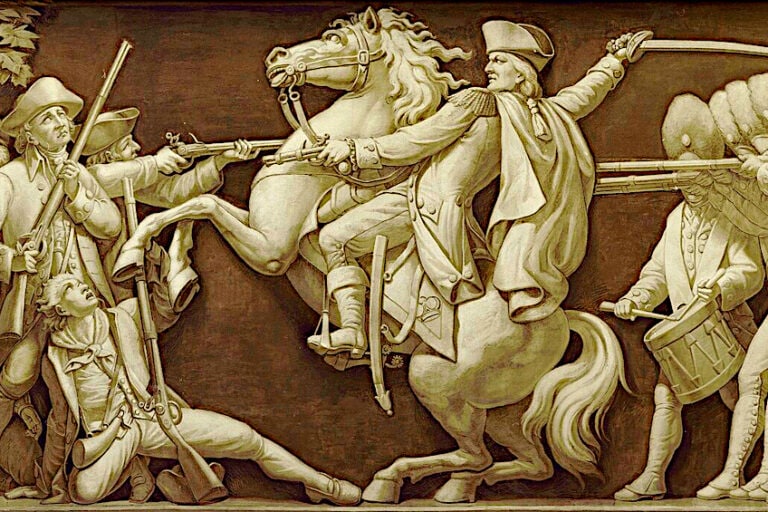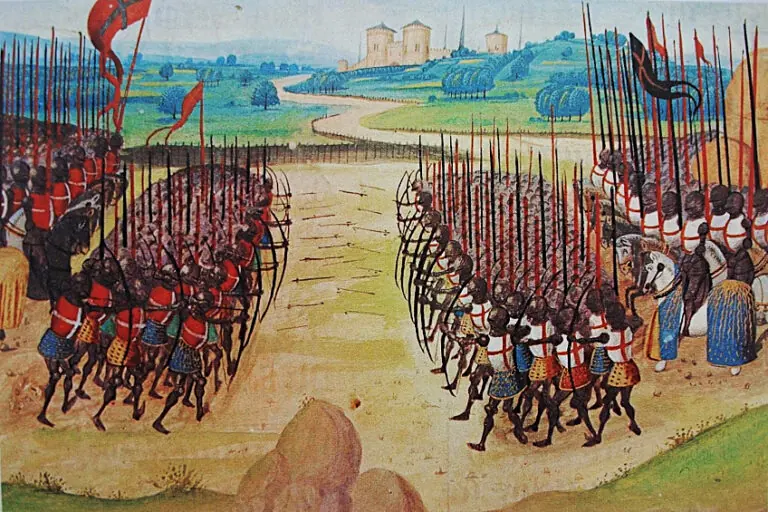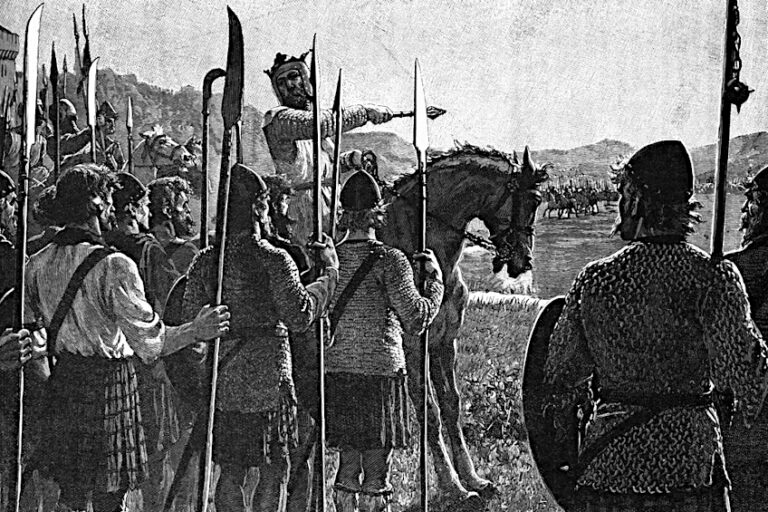Greek Art – 10 Iconic Examples of Ancient Greek Artistry
The art of the ancient Greeks has been deeply influential in the history and development of Western art. Even today many contemporary artists from across the globe still reference the artforms and styles that originated in Greek antiquity. While most people associate the art of ancient Greece with sculpture from the Classical period, the art of ancient Greece encompassed multiple styles and forms, ranging from sculpture to painting, mosaic art, jewelry, metalwork, and ceramics. In this article, we will explore the art of ancient Greece, including examples of ancient Greek art, architecture, and artifacts that were influential in the development of art as we know it today.
Origins and Development of Ancient Greek Art
What most people will instantly recognize as Greek art generally represents only a small fraction of the arts produced by the Ancient Greeks. Greek art traces its origins back to the Cycladic (c. 3100-1000 BCE), Minoan (c. 3500-1100 BCE), and Mycenean (c. 1750-1050 BCE) civilizations. Each of these cultures produced art with distinctive characteristics.
Cycladic art comprises largely abstracted forms, that to the untrained eye can resemble Modern sculpture. Minoan art is known for its fluid lines and incorporation of images from nature, while Mycenean art incorporated many Minoan elements, but in a more severe style.
 Cycladic marble statuette depicting a woman (2700-2600 BCE); Metropolitan Museum of Art, CC0, via Wikimedia Commons
Cycladic marble statuette depicting a woman (2700-2600 BCE); Metropolitan Museum of Art, CC0, via Wikimedia Commons
After the collapse of these proto-Greek civilizations, which some scholars have speculated may have been due to environmental disasters, Greece entered its Dark Age (c. 1100-700 BCE), the emergence from which was marked by significant artistic developments as people began to return to living in more socially complex settlements and resumed large-scale international trade. From around the 8th century BCE, Greeks began to rapidly establish trading colonies across the Mediterranean, bringing them into contact with the arts and cultures of diverse populations. These influences became evident in Greek art.
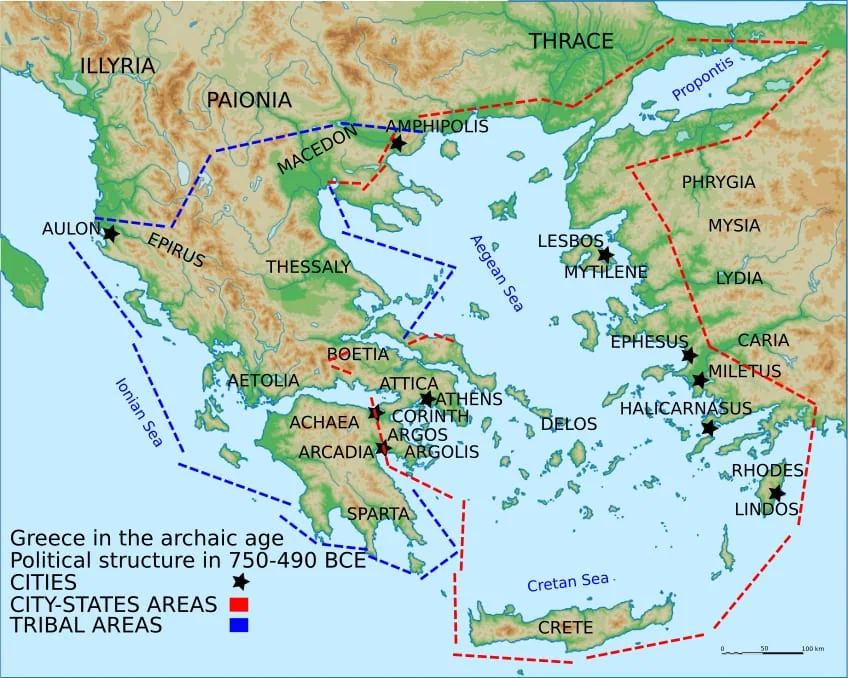 Map of Archaic Greece; MaryroseB54, CC BY-SA 4.0, via Wikimedia Commons
Map of Archaic Greece; MaryroseB54, CC BY-SA 4.0, via Wikimedia Commons
The abstract patterns on Greek pottery of the Geometric period began to feature figurative elements. During the Orientalizing period (700-600 BCE), those figures included monsters such as sphinxes and gryphons, inspired by the arts of the cultures of the Eastern Mediterranean. While in the Archaic period (600-480BCE), the statues of young men (kouros) and women (kore) set up in temple complexes as gifts to the gods, show strong Egyptian influences.
 The Sacred Gate Kouros (c. 600-590 BCE); Jerónimo Roure Pérez, CC BY-SA 4.0, via Wikimedia Commons
The Sacred Gate Kouros (c. 600-590 BCE); Jerónimo Roure Pérez, CC BY-SA 4.0, via Wikimedia Commons
From around 480 BCE Greek art began to assume the stylistic characteristics that it is now best known for. With its political and economic dominance, Athens became a cultural leader amongst the various Greek city-states. Athenian arts became highly influential, particularly following the reconstruction of the destroyed temple complex to the goddess Athena on the Athenian Acropolis.
This undertaking saw major innovations in Greek architecture and sculpture through the construction of such landmark buildings as the Parthenon (447-432 BCE), Erechtheion (c. 420-410 BCE), and the Temple of Athena Nike (420’s BCE).
The greatest Greek artist of the age, Phidias was charged with designing the sculptural program of the Parthenon. Blending of naturalistic forms with notions of the ideal human body became hallmarks of the Greek Classical style.
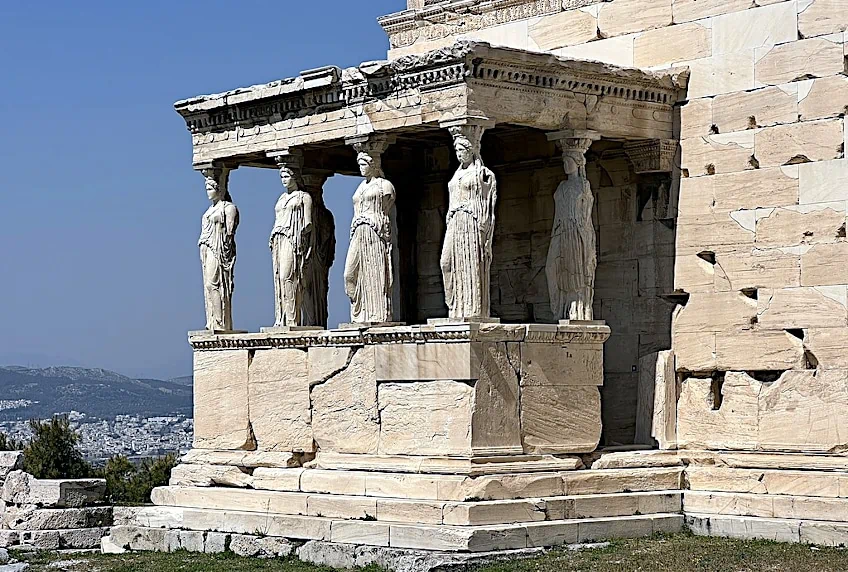 The Caryatid Porch of the Erechtheion (c. 420-410 BCE); Chabe01, CC BY-SA 4.0, via Wikimedia Commons
The Caryatid Porch of the Erechtheion (c. 420-410 BCE); Chabe01, CC BY-SA 4.0, via Wikimedia Commons
The festivals of Dionysus with their dramatic performances based on increasingly novel interpretations of traditional myths greatly influenced vase painters who crafted a range of vessels decorated with various interpretations of these stories.
The Hellenistic period (c. 323 BCE -31 CE) is widely regarded as the first true example of globalization. Cultural interaction between a vast range of peoples across a large geographical area reached an unprecedented peak, and is reflected in the art of this period. The art and culture of the Greeks were adopted, adapted, and re-interpreted, resulting in a hybrid style that suggested decadence, decay and loss of aesthetic integrity to 19th-century art critics. However, Hellenistic art is now greatly appreciated for its complexity, dynamism, and range of technical and conceptual innovations. The obsession with perfection that had characterized Classical art gave way to a far greater appreciation of natural forms and their expressive potentialities.
 Roman copy of Laocoön and His Sons, by Agesander, Athenodorus and Polydorus of Rhodes (2nd Century BCE); Vatican Museums, Public domain, via Wikimedia Commons
Roman copy of Laocoön and His Sons, by Agesander, Athenodorus and Polydorus of Rhodes (2nd Century BCE); Vatican Museums, Public domain, via Wikimedia Commons
While the term “Classicism” is commonly used to indicate the influence of ancient Greek art on subsequent artistic periods and movements, it was the art of the Hellenistic period that proved most influential, especially during the Renaissance and Baroque. After all, it was the Hellenistic masterpiece Laocoön and his Sons which became the sensation of Renaissance Italy when excavated in 1506.
Ancient Greek Art Forms
Traditionally, art historians described Greek art in terms of Joachim Winkelmann’s notion of a developmental route similar to an organism that is born, enjoys a period of growth, maturity, and eventual decline.
Contemporary scholars prefer to study the art of the ancient Greeks in terms of the social and cultural role of each type of artifact produced.
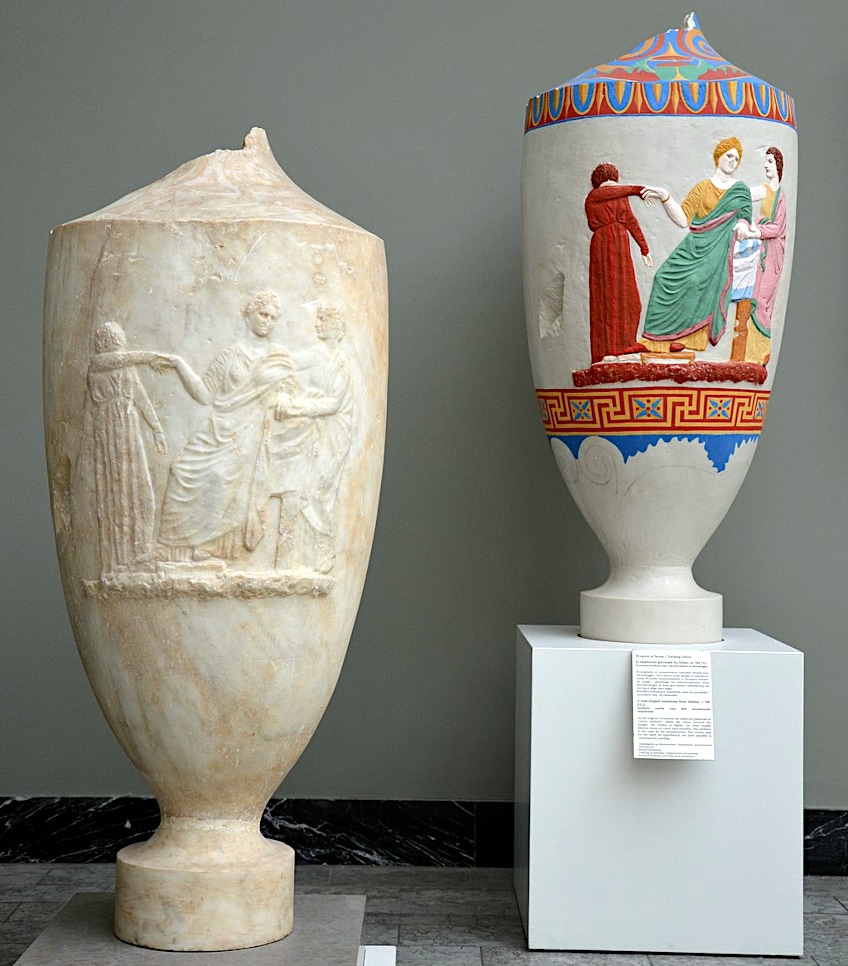 Vase-shaped tombstone from Athens from c. 330 BCE with modern polychrome reconstruction; Carole Raddato from FRANKFURT, Germany, CC BY-SA 2.0, via Wikimedia Commons
Vase-shaped tombstone from Athens from c. 330 BCE with modern polychrome reconstruction; Carole Raddato from FRANKFURT, Germany, CC BY-SA 2.0, via Wikimedia Commons
Ancient Greeks developed many art forms ranging from sculpture to pottery, painting, mosaic art, metalwork, jewelry, and utilitarian items, and architecture. Below, we will delve into some of the major art forms of the Greek arts.
Painting
Ancient Greek painting has its origin in the civilizations of Minoan and Mycenaean cultures. Materials used by ancient Greek artists included a variety of mineral-based pigments such as yellow and red ochre, charcoal black, and white lead. These materials were used to create brilliant decorative frescoes, which were applied on surfaces such as stucco, wood, and stone.
Some of the most important painting techniques used in ancient Greek paintings included tempera and encaustic methods.
Tempera paintings involved a mixture of pigments using a binder such as egg yolk to create a durable substance. On the other hand, encaustic painting involved the heating of beeswax fused with pigments and applied to a surface while the mixture was still hot. The fragility of ancient frescoes means that most of ancient Greek painting has been lost to time. Modern viewers can gain some idea into what these may have looked like from from painted pottery and remaining fragments of murals, frescoes, mosaic copies, and descriptions from ancient Greek and Roman literature.
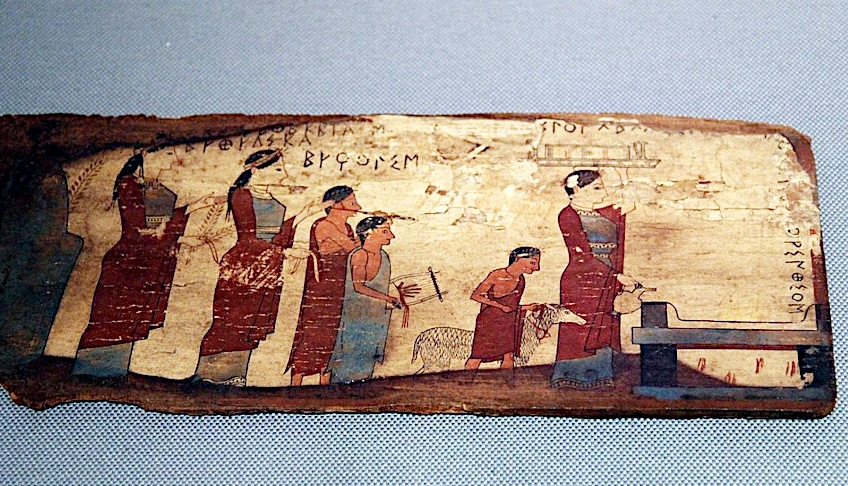 Painted wooden votive plaque depicting a procession to an altar to sacrifice a lamb (540-530 BCE); Gary Todd from Xinzheng, China, CC0, via Wikimedia Commons
Painted wooden votive plaque depicting a procession to an altar to sacrifice a lamb (540-530 BCE); Gary Todd from Xinzheng, China, CC0, via Wikimedia Commons
Among the top three painters of ancient Greek art include figures like Polygnotus (c. 5th century BCE), Zeuxis (c. 5th century BCE), and Apelles (c . 4th century BCE), each of whom made significant contributions to painting styles, narrative mural works, and Realism.
Sculpture
Ancient Greek sculpture ranks amongst the most commonly misunderstood artforms. These works were never designed to be seen the way modern viewers experience them. Greek sculptures were painted in a variety of colors (known as polychromy). Many also had accessories such as weapons, jewelry, clothing, and so on, made from a range of materials.
Sculptural works populated public, sacred, and domestic spaces as gifts to gods, memorials to heroes, household guardians, portraits, tomb markers, and even decorations.
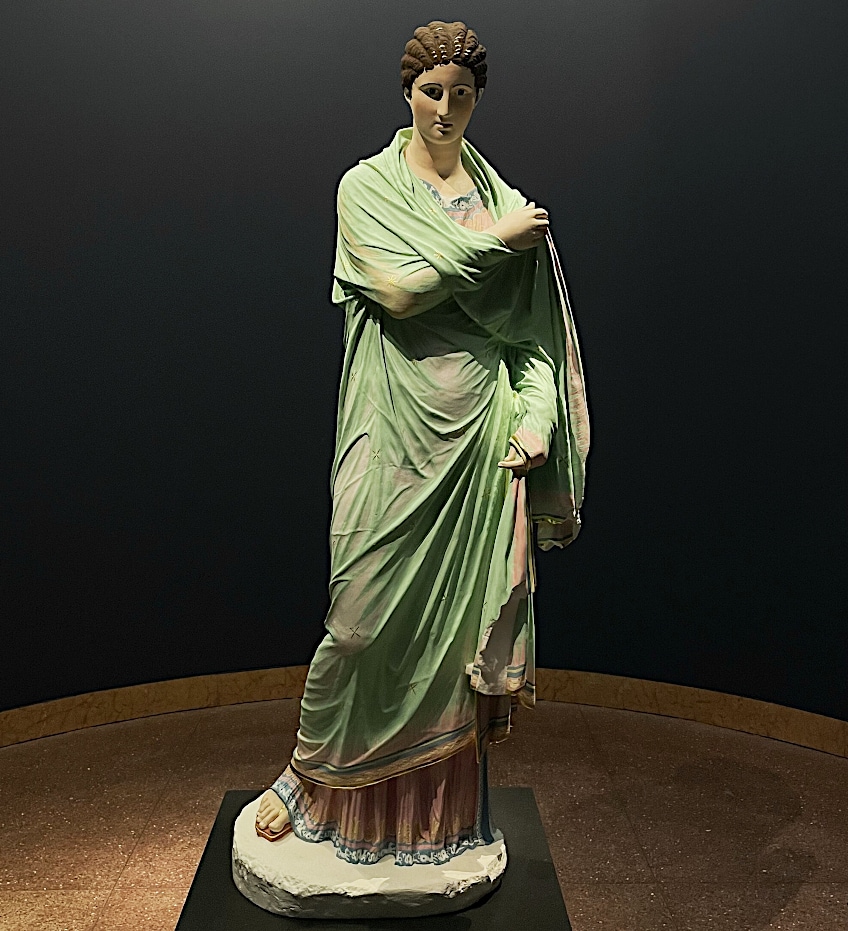 Modern cast with reconstructed polychromy of the statue of the so-called Small Herculaneum Woman from Delos (2nd Century BCE); Aquaplaning, CC BY-SA 4.0, via Wikimedia Commons
Modern cast with reconstructed polychromy of the statue of the so-called Small Herculaneum Woman from Delos (2nd Century BCE); Aquaplaning, CC BY-SA 4.0, via Wikimedia Commons
Originating as far back as the 7th century BCE, Greek sculpture took the form of terracotta figurines produced on a small scale and evolved into monumental works of art sculpted in stone. The sculpture of the human form was also focused on depicting the idealized human body to promote the concepts of beauty, proportion, and harmony in art. Sculptors like Phidias and Myron of the Classical period also produced a shift toward Naturalism and Realism in sculpture with iconic works such as the Discobolus and the Parthenon frieze.
Dynamic poses and intricate details crept in during the Hellenistic period and elevated sculpture to new heights with greater emotional intensity.
Some of the most famous sculptors in art history emerged from ancient Greece and included figures like Praxiteles, Lysippus, and Scopas. Renowned sculptures such as The Winged Victory of Samothrace and the Loacoön and his Sons are among the most famous Hellenistic sculptures that showcase the mastery of Greek talent, their technical skill, and cultural influences, which left a significant mark on art history.
Architecture
Ancient Greek buildings were constructed from a range of materials including wood, terracotta, and various types of stone. While many civic and public buildings such as assembly halls and commercial spaces were constructed using expensive materials like marble and limestone, the Greeks reserved their best architecture for the gods. Constructing a fine house for a divinity not only ensured their protection for a city, but also attracted visitors, and advertised a community’s economic, political, and military might. As a home of a divinity, these temples needed to embody the aesthetic, moral, and religious ideals of its builders.
Temples like the Parthenon in Athens were designed to be as visually pleasing and proportionally harmonious as possible.
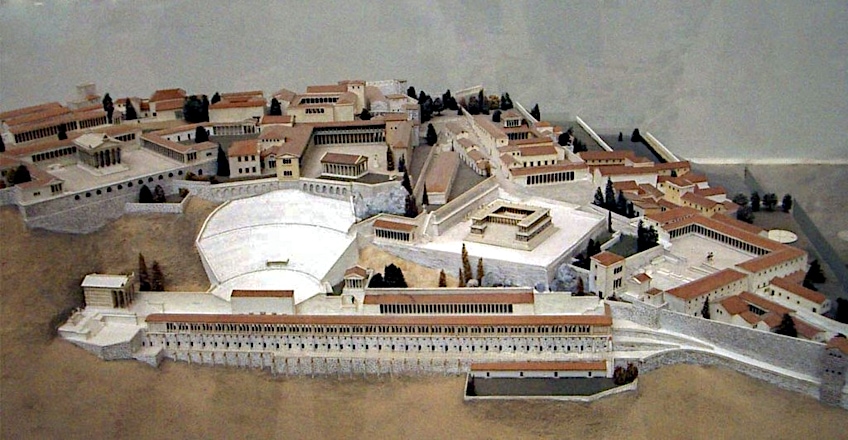 Model of the acropolis of the ancient Greek city of Pergamon in the late 2nd Century BCE; Model: Hans Schleif; Photograph: De:User:Unify, CC BY-SA 3.0, via Wikimedia Commons
Model of the acropolis of the ancient Greek city of Pergamon in the late 2nd Century BCE; Model: Hans Schleif; Photograph: De:User:Unify, CC BY-SA 3.0, via Wikimedia Commons
Important Greek buildings would also be painted in multiple colors and featured elaborate sculptural programs in the form of metope reliefs and friezes. Many of the friezes would generally be near impossible to view from the ground level, but would nonetheless be crafted and painted to very high degree. The idea being that the intended audience for these sculptures were the gods, not the humans who visited the temple.
The development of Greek architecture is generally designated in terms of orders such as the Doric, Ionic, and Corinthian.
The Doric order emerged in the Archaic period and saw the development of plain capitals with sturdy columns. Popular examples of Doric architecture include the Temple of Hera at Olympia and the Temple of Aphaia on Aegina Island. Styles of the Ionic order produced slender columns and elaborately designed volutes, which was common throughout the Classical period. The Erechtheion on the Acropolis of Athens and the Temple of Artemis at Ephesus are prime examples of Ionic design. Greek architecture became increasingly ornate and reached its peak with the Corinthian order, which debuted ornate capitals with acanthus leaves and was popular throughout the Hellenistic period.
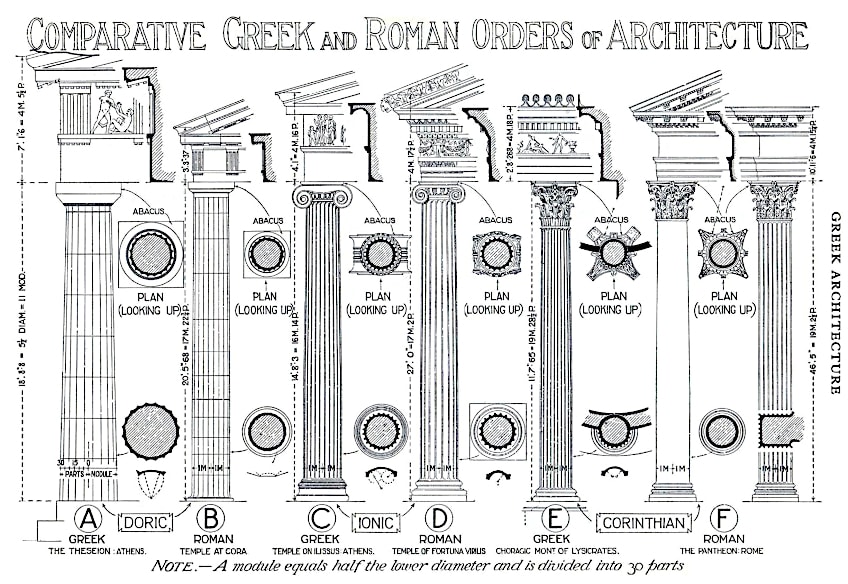 Comparison of the main characteristics of Greek and Roman architectural orders; Sir Banister Flight Fletcher (15 February 1866, London – 17 August 1953, London), Public domain, via Wikimedia Commons
Comparison of the main characteristics of Greek and Roman architectural orders; Sir Banister Flight Fletcher (15 February 1866, London – 17 August 1953, London), Public domain, via Wikimedia Commons
Skilled architects were in high demand by ancient Greek city-states due to their ability to enhance the prestige of these places, and included such luminaries as Ictinus, Callicrates, and Phidias.
Greek architecture went on to influence the West in a multitude of capacities, which cannot be overstated. Through the principles of harmony, proportion, and balance in architecture, Western architecture had been transformed indefinitely. The Romans were the first to adopt many architectural styles from Greek culture and adapted these orders to suit their preferences.
Common Themes and Subjects in Greek Art
Ancient Greek artists portrayed an astonishingly large range of aspects of daily life, through art created as much for prestigious and ideological purposes as for commercial, entertainment, and domestic uses. Terracotta was the plastic of the ancient world, used for everything from storing and shipping oil, grain, wine, and other commodities, every-day items such as cups and plates, to monumental vessels for marking graves and ceremonial uses. A significant percentage of these were decorated with imagery ranging from simple patterns to elaborate scenes on topics such as occupations, religious practices, sports, and banquets, politics, and mythology.
While these themes are broad, they encompass a rich diversity of complex narratives, important practices, and achievements of Greek society.
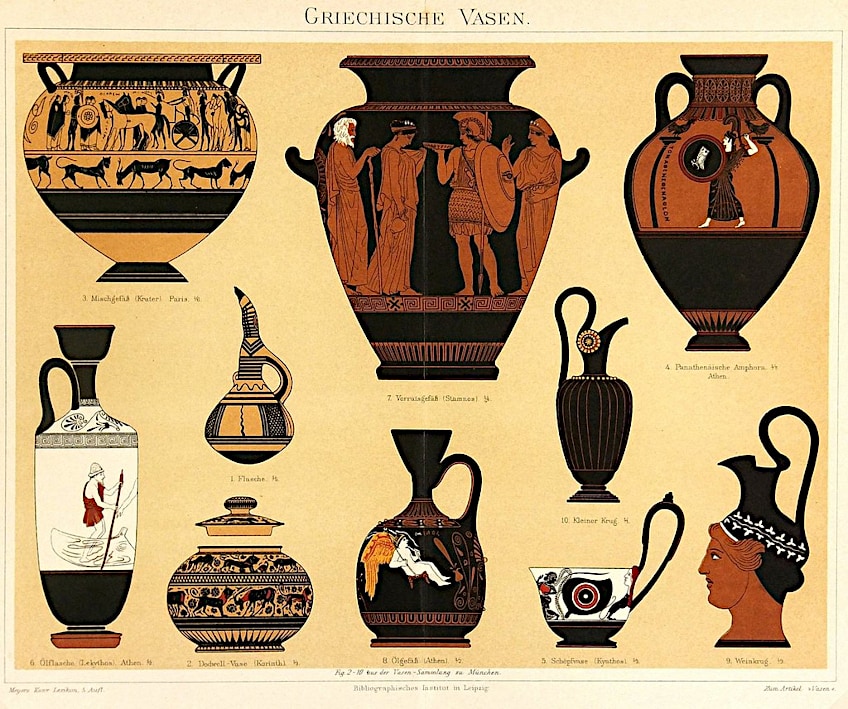 Vintage poster depicting various types of ancient Greek pottery (1898); The lithograph has been printed by Bibliographisches Institut Leipzig.Litho by Meyers Germany 1898, Public domain, via Wikimedia Commons
Vintage poster depicting various types of ancient Greek pottery (1898); The lithograph has been printed by Bibliographisches Institut Leipzig.Litho by Meyers Germany 1898, Public domain, via Wikimedia Commons
The importance of religion in Greek life meant that images of gods and heroes populated sacred, public, and private places alike. Complex reliefs often depicted narrative scenes from regionally-significant scenes from myth, legend, and history. Greek art touched on themes that encompassed nearly every part of what it meant to be an ancient Greek, providing modern scholars with fertile ground to study their lives, ideals, and beliefs.
The broad thematic scope of Greek art is why so many subsequent artists, often with completely different aesthetics and interests, have been able to draw inspiration from some facet of ancient Greek art.
Exploring Iconic Greek Artworks
From the elaborately decorated terracotta and ceramic vases to the detailed frescoes and curious artifacts of ancient Greece, there are many interesting artworks to explore! Below, we have compiled a selection of Greek artwork and artifacts that remain iconic contributions to Greek art history and our understanding of Greek culture.
Terracotta Funerary Plaque (c. 520 – 510 BCE)
| Artist Name | Unknown |
| Date | c. 520 – 510 BCE |
| Medium | Terracotta; black-figure |
| Dimensions (cm) | 26 x 36.2 x 0.9 |
| Where It Is Housed | The Metropolitan Museum of Art, New York City, United States |
This black-figure painted plaque was created in the 6th century BCE as a funerary plaque and represents the archaic painting style of ancient Greece. The scene features a chariot race at the bottom with a larger scene called prosthesis, which was the laying out of the dead. A series of single plaques were created for installation in the walls of rectangular tombs as a replacement for the previous funerary plaques.
The painting is characteristic of Attic funerary art includes in the lower register a reference to the funerary games held in honor legends and heroes such as Patroclus in the Iliad.
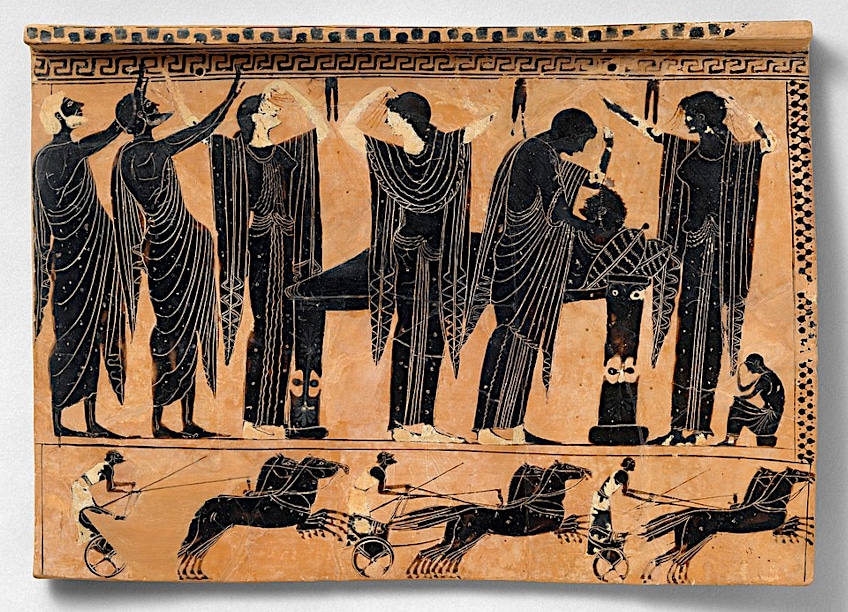 Attic terracotta funerary plaque (c. 520-510 BCE); Metropolitan Museum of Art, CC0, via Wikimedia Commons
Attic terracotta funerary plaque (c. 520-510 BCE); Metropolitan Museum of Art, CC0, via Wikimedia Commons
Bronze Centaur (c. 5th Century BCE)
| Artist Name | Unknown |
| Date | c. 5th century BCE |
| Medium | Bronze |
| Dimensions (cm) | 4.4 (h) |
| Where It Is Housed | The Metropolitan Museum of Art, New York City, United States |
Representative of Greek Classical art, this 5th-century centaur was a popular motif in ancient Athenian art and was included in the decoration of the Theseion, which featured large wall frescoes with scenes of Greeks engaged in battle with centaurs, Lapiths, and Amazon warriors. Centaurs were also common motifs used in sculpture and featured in work found at the Parthenon. This bronze centaur is throwing a boulder, which was a reference to a Greek myth describing a Lapith named Kaineus, who was invulnerable to man-made weapons and could only be defeated by beating him with stones and trees.
 Bronze statuette of a Centaur (c. 5th Century BCE); Metropolitan Museum of Art, CC0, via Wikimedia Commons
Bronze statuette of a Centaur (c. 5th Century BCE); Metropolitan Museum of Art, CC0, via Wikimedia Commons
Animals were used in ancient Greek symbolism as icons that represented a variety of values and ideas.
Other common animal motifs included lions, associated with power and royalty, as well as dolphins, associated with the sea God Poseidon, and eagles, which were associated with Zeus, and symbolized man’s connection to the heavens. Snakes were also commonly depicted in Greek art as negative and positive symbols associated with wisdom, fertility, the Chthonic realm, healing, and danger. Bulls were potent symbols of sacrifice, strength, and fertility and were often portrayed in religious narratives and myths such as the half-human and half-bull Minotaur.
Tomb of the Diver (c. 480 BCE)
| Artist Name | Unknown |
| Date | c. 480 BCE |
| Medium | Frescoes |
| Dimensions (cm) | Varied |
| Where It Is Housed | Paestum, Magna Graecia, Italy |
Tomb of the Diver is one the most famous examples of ancient Greek fresco paintings executed for funerary decorations for the Greek colonies in Italy. The tomb was discovered in 1968 by Mario Napoli and is currently known as the only complete surviving work that represents the styles from the Greek Orientalizing, Archaic, and Classical periods. The tomb was built in Poseidonia, which later became known as Paestum, and was constructed from limestone and incised with a stylus. Thin red lines were created on the walls to draw on images and various pigments with shades of black, red, blue, green, and white were used for the frescoes.
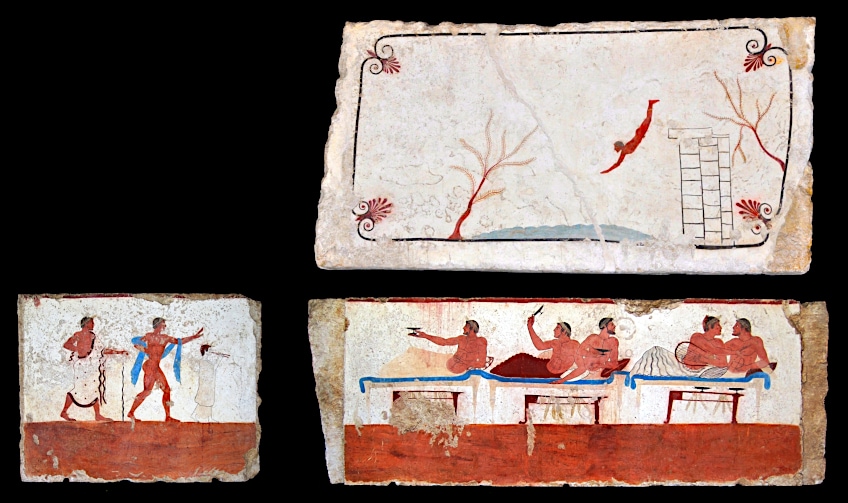 Symposium and diving scenes from the Tomb of the Diver (470-480 BCE); Velvet modified (I put the five panels together, with proportions respected within a 2% margin of error) by Firedrop, CC BY-SA 3.0, via Wikimedia Commons
Symposium and diving scenes from the Tomb of the Diver (470-480 BCE); Velvet modified (I put the five panels together, with proportions respected within a 2% margin of error) by Firedrop, CC BY-SA 3.0, via Wikimedia Commons
The human figures in the frescoes were depicted in a symposium setting and were outlined in black with smaller anatomical details added after.
Symposium scenes were common in Attic pottery paintings and included scenes where men were playing the game kottabos. All the figures in the paintings were illustrated with crowns with the most popular fresco portraying a diver on the roof slab. What makes this fresco incredibly unique is that it is an extremely rare depiction rendered in high detail found in a symposium scene. The details on the diver’s ribs featured complex patterns and scholars speculate that the scene was associated with the Greek mind and the intensity of death. The tomb was thus a deviation from the traditional representations of symposium gatherings and was a sign of political integration amid the “pleasure of wine-drinking” after death.
Statue of Zeus at Olympia (c. 466 – 435 BCE)
| Artist Name | Phidias |
| Date | c. 466 – 435 BCE |
| Medium | Gold, bronze, ivory, and ebony |
| Dimensions (cm) | 13,000 |
| Where It Was Housed | Olympia, Greece |
The now-destroyed Statue of Zeus was perhaps one of the greatest Greek sculptures of all time and made the ancient list of Seven Wonders of the World. This monumental sculpture was crafted from gold and ivory and depicted the Greek God Zeus seated inside his temple at Olympia, home of the ancient Olympic games. The sculpture was created by Phidias, who portrayed the god at a towering height of 13 meters high. Zeus’ throne was crafted from cedarwood and decorated with precious stones. Phidias took eight years to complete the statue, however, according to most accounts it was destroyed around 426 BCE, although there have been suggestions that it may have been relocated to Constantinople at some point in late antiquity.
A sculptor’s workshop, tentatively ascribed to Phidias was found during excavations in Olympia.
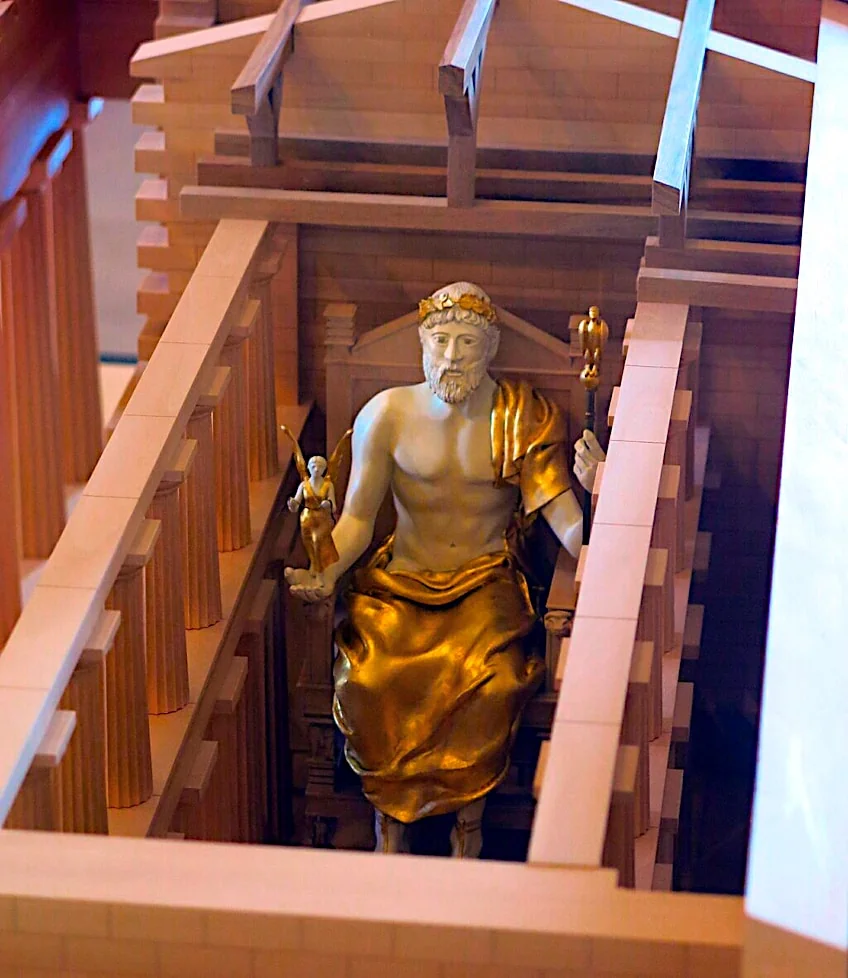 Modern model showing the projected scale of the lost statue of Zeus in his temple at Olympia; Tangopaso, Public domain, via Wikimedia Commons
Modern model showing the projected scale of the lost statue of Zeus in his temple at Olympia; Tangopaso, Public domain, via Wikimedia Commons
The Temple of Athena Nike (c. 427 BC – 424 BCE)
| Architect Name | Unknown |
| Date | c. 427 BC – 424 BCE |
| Medium | Pentelic marble |
| Dimensions (cm) | 827 x 564 x 400 |
| Where It Is Housed | Attica, Athens, Greece |
The Temple of Athena Nike is one of the most famous architectural structures of ancient Greece that was completed around the late 5th century. It was destroyed by the Ottoman Empire, badly restored in 1834, only to be dismantled again, and finally reconstructed in 2010. This historic temple was built with Pentelic marble, which was a high-quality marble sourced from Mount Pentelicus, near Athens. The temple was dedicated to the goddess Athena in her aspect as bringer of victory, and was designed in the Ionic style with four towering Ionic columns located at the front and back. The frieze, metopes, and walls of the temple were also decorated with mythological and battle relief sculptures.
Situated overlooking the main entrance to the Acropolis, the temple symbolized the power and dominance of Athens and represented its cultural achievements.
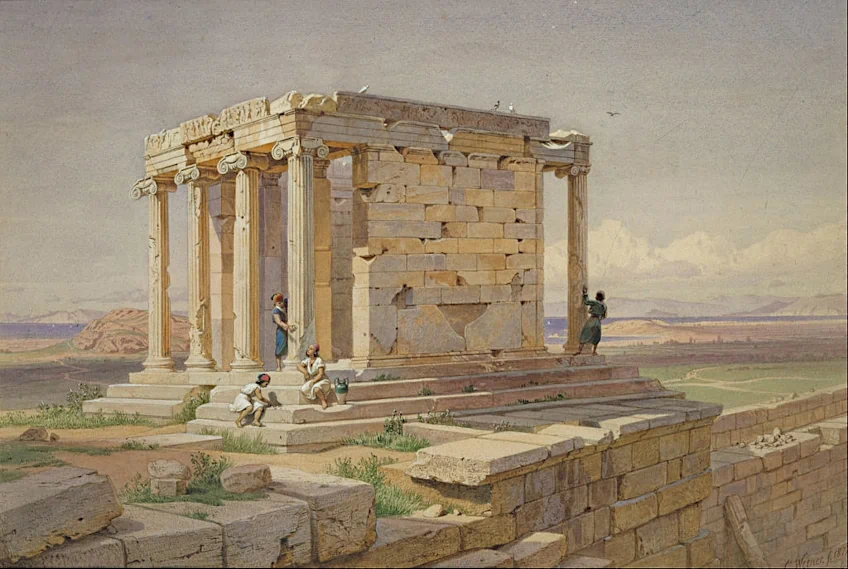 The Temple of Athena Nike. View from the North-East by Werner Carl-Friedrich (1877); Benaki Museum, Public domain, via Wikimedia Commons
The Temple of Athena Nike. View from the North-East by Werner Carl-Friedrich (1877); Benaki Museum, Public domain, via Wikimedia Commons
Statue of Eros Sleeping (c. 3rd – 2nd Century BCE)
| Artist Name | Unknown |
| Date | c. 3rd – 2nd Century BCE |
| Medium | Bronze |
| Dimensions (cm) | 41.9 x 35.6 x 85.2 |
| Where It Is Housed | The Metropolitan Museum of Art, New York City, United States |
The Hellenistic era saw Greek art focus on the representation of age and featured young children from mythology such as Eros and Herakles in various playful genre scenes. Eros was captured here by an unknown Greek sculptor in bronze and was the God of love who was sent to Earth unarmed. This Greek statue of Eros the infant is one of the few surviving bronzes from antiquity that portrays an infant Eros in such an intimate manner.
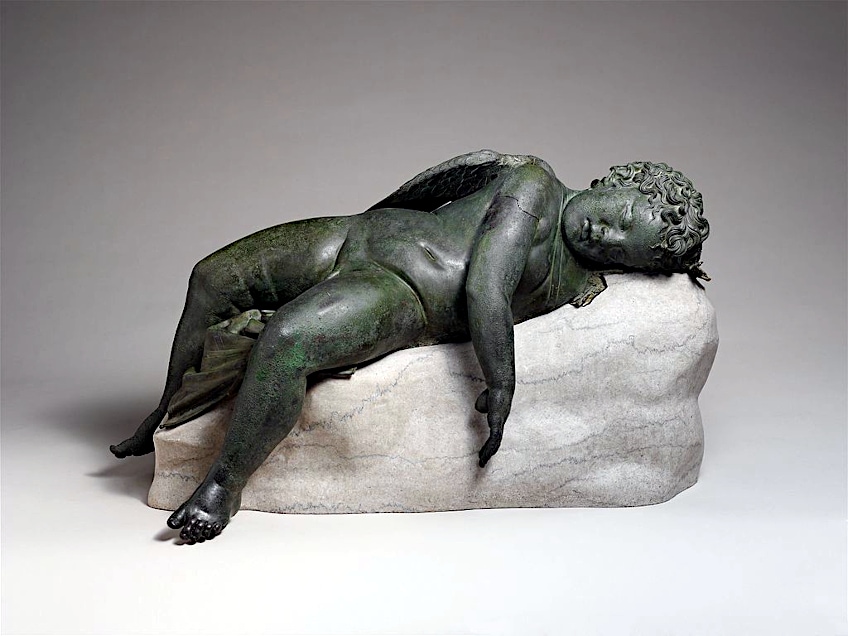 Bronze Statue of Eros Sleeping (3rd – 2nd Century BCE); Metropolitan Museum of Art, CC0, via Wikimedia Commons
Bronze Statue of Eros Sleeping (3rd – 2nd Century BCE); Metropolitan Museum of Art, CC0, via Wikimedia Commons
The sculpture is a prime example of Hellenistic Greek sculpture and was especially popular throughout Roman rule.
While the function of the Eros statue was unclear, scholars concluded that it may have been a votive statue that was once housed in a sanctuary dedicated to Aphrodite or for public viewing in a royal space or private garden.
Aphrodite de Milos (c. 150 – 125 BCE)
| Artist Name | Alexandros of Antioch |
| Date | c. 150 – 125 BCE |
| Medium | Parian marble |
| Dimensions (cm) | 204 |
| Where It Is Housed | The Louvre, Paris, France |
This renowned Greek sculpture called Aphrodite de Milos or Venus de Milo is a famous Hellenistic Greek statue that was recovered in 1820 on the island of Milos. The statue portrays the goddess Aphrodite carved in Parian marble with visible polished and chiseled markings and missing limbs. The statue was discovered by a local farmer and Olivier Voutier who uncovered the sculpture in three separate parts.
Inscriptions that were allegedly discovered on the sculpture, included a dedication by Bakchios, the son of Satios, and another naming the artist Alexandros of Antioch. The inscriptions have since disappeared. The sculpture remains an iconic part of Greek history and is currently housed at the Louvre Museum in Paris.
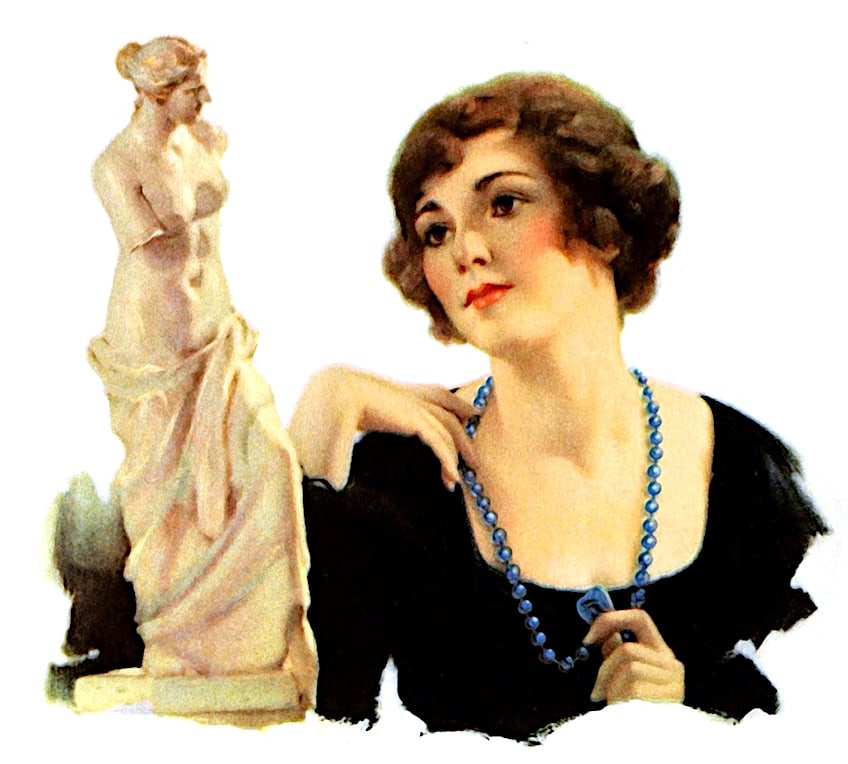 Image of the Aphrodite/Venus de Milos as used in the Ideals of Beauty advertisement for Palmolive soap in 1926; AnonymousUnknown author, Public domain, via Wikimedia Commons
Image of the Aphrodite/Venus de Milos as used in the Ideals of Beauty advertisement for Palmolive soap in 1926; AnonymousUnknown author, Public domain, via Wikimedia Commons
Interesting Ancient Greek Artifacts
Ancient Greek artifacts encompass a diverse collection of unique objects from antiquity that reflect the cultural, artistic, and historical achievements of the past. From ornate jewelry to exquisitely designed objects, one can admire the remarkable craftsmanship of early Greek artists. Below, you will find a selection of ancient Greek artifacts that continue to captivate and inform our knowledge of past artistic practices that shaped Western culture.
Bull’s Head Amulet (c. 700 – 650 BCE)
| Artist Name | Unknown |
| Date | c. 700 – 650 BCE |
| Medium | Bone inlaid with silver |
| Dimensions (cm) | 3.81 (l) |
| Where It Is Housed | The British Museum, London, United Kingdom |
Derived from the Orientalizing period in ancient Greece, this tiny amulet depicts a bull’s head inlaid with silver eyes, which was probably used as a pendant on a necklace. The amulet was crafted from bone during the late 8th and 7th centuries and was discovered by Sir Alfred Biliotti and Auguste Salzmann. Bone was used to creating amulets for different purposes and was primarily used as a protective charm to ward off evil and invite good fortune.
These amulets were crafted from animal bones of small mammals, including fish and birds, and carved with symbols and designs.
The ancient Greeks believed in the power of supernatural forces and the impact they had on human life so amulets were created as a means for people to harness these forces and use them to ward off malevolent spirits and illnesses. The bull was a common motif in Greek art and was included in talismans for strength, fertility, and power. Bone was thus a superstitious material that was related to funerary practices to honor the dead and was also placed with the dead as talismans for protection in the afterlife.
Terracotta Comic Mask (c. 4th – 3rd Century BCE)
| Artist Name | Unknown |
| Date | c. 4th – 3rd century BCE |
| Medium | Terracotta |
| Dimensions (cm) | 4.8 (h) |
| Where It Is Housed | The Metropolitan Museum of Art, New York City, United States |
This artifact is a miniature version of terracotta comic mask of the type used in the late-4th century New Comedy era. Masks originated in Greek theater around the 5th century BCE and became a tradition rooted in ritualistic and religious practices. Their practical use extended to theater for actors to portray different characters and a few theaters would employ a limited number of actors to use the masks to differentiate between numerous characters.
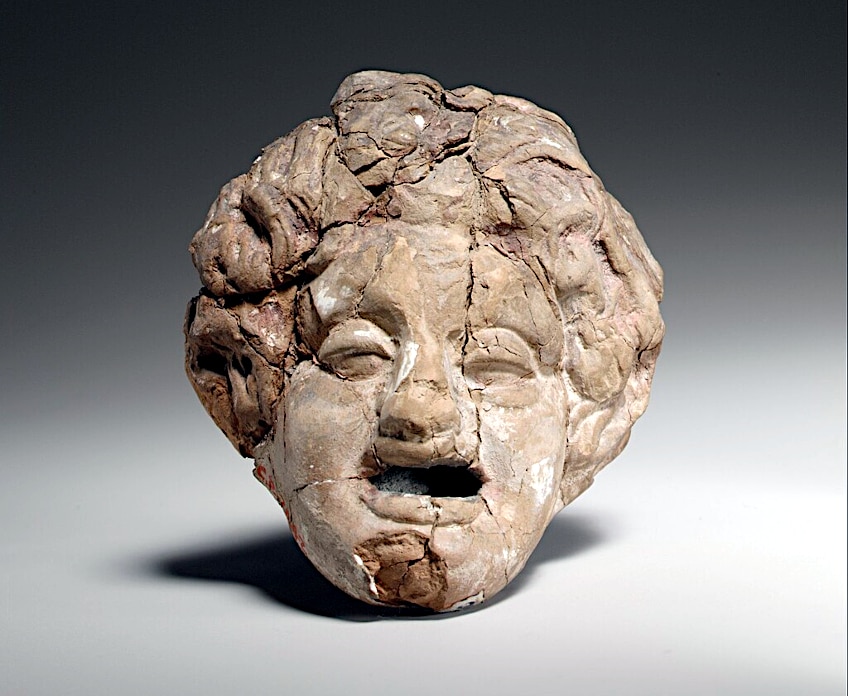 Terracotta Comic Mask (c. late 4th – 3rd Century); Metropolitan Museum of Art, CC0, via Wikimedia Commons
Terracotta Comic Mask (c. late 4th – 3rd Century); Metropolitan Museum of Art, CC0, via Wikimedia Commons
Larger masks were crafted by skilled artisans who used materials like linen, cork, and wood to create masks with exaggerated expressions associated with the character.
These expressions made it easy for crowds to identify a character and recognize the emotion. Masks also served a symbolic purpose since they were seen as vessels through which actors could connect to the divine and invoke the spirit of mythical beings. Beyond the theater, masks were also used in spiritual and religious events to refer to the God Dionysus, who was the god of wine and theater, as well as festivals.
Carnelian Stone on Silver Ring; Crouching Woman (c. 3rd Century BCE)
| Artist Name | Unknown |
| Date | c. 3rd century BCE |
| Medium | Carnelian, gold, and silver |
| Dimensions (cm) | 1.5 (l) |
| Where It Is Housed | The Metropolitan Museum of Art, New York City, United States |
This exquisite ancient Greek artifact is a vibrant carnelian and gold masterpiece set on a silver ring and depicts an image of a woman crouching. There are many similar artifacts with carnelian as a sculptural material used for engraving and incising personal motifs. The reddish-orange stone was used in art and jewelry practices as a symbol of protection and healing.
The stone was a popular choice for the creation of amulets, jewelry pieces, and talismans that were used for personal adornment and was associated with vitality, courage, and strength.
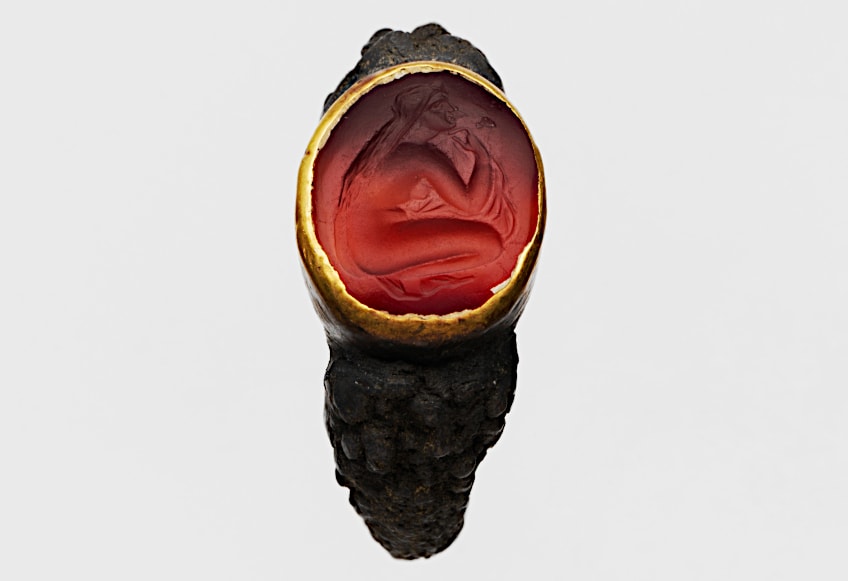 Carnelian stone set in silver ring (c. 3rd Century BCE); Metropolitan Museum of Art, CC0, via Wikimedia Commons
Carnelian stone set in silver ring (c. 3rd Century BCE); Metropolitan Museum of Art, CC0, via Wikimedia Commons
The vibrant color of Carnelian also made for a visually striking piece that complemented other materials such as ivory, gold, and silver. Carnelian was sourced from multiple regions, including the Near East and Mediterranean, and was also connected to Greek religion and mythology. The stone was associated with deities like Apollo and Dionysus and offered a spiritual dimension to artworks.
Ancient Greek art established the foundations for many Western artistic traditions that shaped the course of artistic expression across pottery, sculpture, architecture, and painting. These fascinating ancient Greek artifacts and artworks provide much to ponder over the culture, religion, and values of Greek society and their legacy in inspiring scholars and artists.
Frequently Asked Questions
What Is Ancient Greek Art?
Works defined as ancient Greek art were produced on islands and various land areas bordering the Mediterranean for over three thousand years, beginning with the Cycladic and Cretan art of the Bronze Age all the way through to the Hellenistic period. These include sculptures, pottery, paintings, architecture, metalwork, and jewelry. For most of Western art history, Classical Greek art propelled the development of art styles such as Naturalism, and the concepts of an idealized human form, balance, harmony, and proportion. Later on, Modernists such as Pablo Picasso also found inspiration in the lesser-known art of the Archaic Greek and Cycladic periods. Ancient Greek art reflects the broad range of cultural, religious, and philosophical ideas of Greek antiquity.
Who Was the Most Famous Ancient Greek Artist?
Phidias of the 5th century BCE was widely considered to be the most famous Greek architect and sculptor of antiquity. While he was credited with creating many iconic sculptures, no works by him survived, meaning that his style can only be deduced from the various Roman copies of his works, which included the gold and ivory statues of Statue of Zeus at Olympia and of Athena that was housed in the Parthenon in Athens. Apelles of Kos who lived in the 4th century BCE was the most famous of ancient Greek painters, while the most famous ceramicist was named Exekias (6th century BCE) who specialized in black-figure painting and is considered one of the most influential figures in Ancient Greek vase-painting.
What Is the Most Famous Building from Ancient Greece?
The Parthenon (c. 447 BCE) is considered to be the most famous architectural landmark from ancient Greece, which was built on the Athenian Acropolis in Greece and dedicated to the goddess Athena. The idea for building the Parthenon as it exists now was led by Pericles the great Greek statesman following the destruction of the old temple by the Persians. The Parthenon was designed by the architects Ictinus and Callicrates while the sculptural program was created by Phidias.

I am deeply passionate about history and am constantly fascinated by the rich and complex stories of the past. As the editor-in-chief of learning-history.com, I have the opportunity to share this passion with a wide audience through the creation and distribution of engaging and informative content about historical events, persons, and cultures. Whether it’s through writing articles and blog posts or creating videos or podcasts, I strive to bring the past to life in a way that is both accurate and enjoyable. My expertise in history, combined with my strong writing and communication skills, allows me to effectively communicate complex historical concepts and make them accessible and interesting to a wide range of readers. I am truly grateful for the opportunity to share my love of history with others through my work on learning-history.com.



